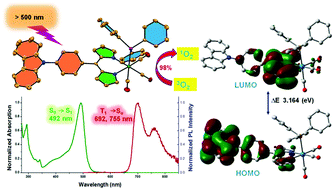Phosphorescent rhenium-dipyrrinates: efficient photosensitizers for singlet oxygen generation†
Abstract
A series of rhenium(I) dipyrrinato complexes (Re1–Re8) have been prepared and characterized; their crystal structures, phosphorescence and singlet oxygen generation studies are reported. The aromatic substituents, such as thienyl, p-bromophenyl, p-fluorophenyl, m-fluorophenyl, pentaflurophenyl, N-butylcarbazole, N-phenylcarbazole, and N-butylphenothiazine, are linked to the C5 position of Re-dipyrrinates. Varying the electronic nature of the substituents from electron donating (e.g., carbazole) to electron withdrawing (e.g., pentaflurophenyl) allowed the change in the structural, electrochemical, and spectroscopic properties of these complexes. In particular, the rhenium dipyrrinates showed phosphorescence in the near IR region with sufficiently longer triplet state lifetimes (τT = 9–29 μs). Also, a large Stokes shift (Δν = 5682–6957 cm—1) was witnessed for all the rhenium dipyrrinates. Triplet emission was reflected in the efficient singlet oxygen generation yields (ΦΔ ∼ 0.75–0.98) along with the distinct photo-stability. Density functional theory (DFT) calculations revealed that the electron density is spread over the dipyrrin unit in most complexes. Rhenium dipyrrinate having a phenothiazine substituent exhibited the smallest HOMO–LUMO band gap (2.820 eV) among all Re-complexes.



 Please wait while we load your content...
Please wait while we load your content...